Jan Vermeer Biography
The esthetic tastes of nowadays rank Jan Vermeer as one of the most original painters of 17th century Holland, despite the fact that he created no more than forty or so paintings. He remained relatively ignored during his own brief lifetime, and only in the 19th century his work was highly appreciated.
Jan Vermeer (or Jan van der Meer, or Jan Vermeer van Delft) was born in 1632, the second child of Reynier Janszoon Vos and Digna Baltens. Reynier, besides his other businesses, was an art dealer and had relations with some artists of his time, including Balthasar van der Ast, Pieter Steenwyck, and Pieter Groenewesen. Maybe these contacts gave the young Vermeer his first artistic inclination. Nothing is known about his training as a painter, but in 1653 he was admitted as a master to the Guild of St. Luke, which united painters in all genres, glass makers, faience makers, embroiderers and art dealers; as a precondition for being admitted was an obligatory six-year training with a master, recognized by the Guild.
On 20 April 1653 Vermeer married Catharina Bolnes, who bore him 15 children, 4 of them died when still very young.
Vermeer probably painted very little for the public art market, most of his work being produced for those patrons who particularly valued his work. This may also account for the modest number of paintings he produced.
Christ in the House of Mary and Martha (c.1654-1655) is one of Vermeer’s earliest paintings. Paintings of biblical themes were classified as histories, which were described in treatises on art as most distinguished tasks. Vermeer probably wanted to demonstrate his abilities in this genre upon entry to the Guild of St. Luke. Diana and Her Companions (c.1655-1656) is another early work by Vermeer; the theme on this occasion derives from mythology. These themes are not typical of Vermeer. He almost always chose as subject matter glimpses of daily life, and almost invariably interiors, though there are in his heritage a couple of views of Delfi: Street in Delfi (c.1657-1658), View of Delfi (c.1660-1661). His paintings are calm with very few figures, generally no more than one or two, usually women alone (women in love, reading or writing love letters, playing musical instruments; women at work). Vermeer offers the most impressive reflection of the sophisticated side of seventeenth-century Dutch life; its love for fine furniture, attractive women, lavish clothing, and maps decorating interiors: The Art of Painting (c.1666-1673), Woman with a Water Jug (c.1664-1665) and others. The role of maps was twofold; on the one hand, they indicated wealth, in the seventeenth century, maps were an expensive luxury; on the other hand, they refer to a good level of education.
Vermeer’s pictures are also moralizing, thus women who had become intoxicated on wine were considered to be the embodiment of sin, and this is a central motif to some of Vermeer’s works: The Glass of Wine (c.1658-1660). Soldier and a Laughing Girl (c.1658), Woman and Two Men (c.1659-1660). On each of these pictures men are trying to seduce young women by giving them wine. Evidently Vermeer supported the view of his time that alcohol was the first step towards whoring and women should be forbidden drink altogether. There are also many hints and symbols in Vermeer’s pictures, which his contemporaries understood, but we, not knowing their meanings, see in his painting artistic representation of the everyday life of those times.
In almost all his pictures Vermeer is experimenting with light, radiant light comes from somewhere beside or behind the canvas. Jewelry gleams prettily in the light; wet lips, bright eyes catch the light; reflections from window glass, kitchen utensils fall on surrounding objects, creating an atmosphere of peace and serenity. Vermeer preferred cool tones of blue, white and yellow: Girl with a Pearl Earring (c.1665), The Milkmaid (c.1658-1660), The Lacemaker (c.1669-1670), Lady Seated at a Virginal (c.1673-1675) and many others.
Only tree of Vermeer's pictures: The Procuress (1656), The Geographer (c.1668-1669) and The Astronomer (c.1668) are dated. Some art historians consider the left man on The Procuress to be the self-portrait of Vermeer. The Geographer and The Astronomer were produced as a pair, and remained together until 1729.
Besides painting Vermeer also worked as an art dealer. He presumably took over the running of his father’s inn, the “Mechelen”, once his father died.
Vermeer’s later years were overshadowed by a dramatic deterioration of his personal financial position. He got into debt. In 1672 war between France and the Netherlands started. The only way the Netherlands could defend them was to open dikes and flood the land, but this ruined the agriculture. Vermeer’s family was among those who suffered financially, because could not get rent for their estate any longer. His wife later commented, “Because of this and because of the large sums of money we had to spend on the children, sums he was no longer able to pay, he fell into such a depression and lethargy that he lost his health in the space of one and a half days and died.” Vermeer was buried on 15 December 1675 in the family grave at the Oude Kerk, Delft.
Bibliography
Vermeer of Delft by. Yu. Zolotov. Moscow. 1995.
Painting of Western Europe. XVII century. by E. Rotenberg. Moscow. Iskusstvo. 1989.
Painting of Europe. XIII-XX centuries. Encyclopedic Dictionary. Moscow. Iskusstvo. 1999.
Vermeer: A View of Delft by Anthony Bailey. Henry Holt & Company, Inc., 2001.
Girl with a Pearl Earring by Tracy Chevalier. Plume, 2001.
Girl in Hyacinth Blue by Susan Vreeland. Penguin USA, 2000.
Vermeer: The Complete Works by Arthur K., Jr Wheelock, Johannes Vermeer. Harry N Abrams, 1997.
- Christ In The House Of Mary And Martha.
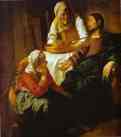
c.1654-1655. Oil on canvas. National Gallery of Scotland, Edinburgh, UK.
- Diana And Her Companions.
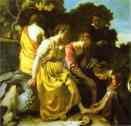
c.1655-1656. Oil on canvas. Mauritshuis, the Hague, Netherlands. Read Note.
- Street In Delfi.
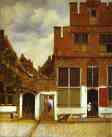
c.1657-1658. Oil on canvas. Rijksmuseum, Amsterdam, Netherlands.
- View Of Delfi.
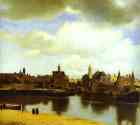
c.1660-1661. Oil on canvas. Mauritshuis, the Hague, Netherlands.
- The Art Of Painting.
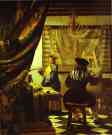
c.1666-1673. Oil on canvas. Kunsthistorisches Museum, Vienna, Austria.
- Woman With A Water Jug.
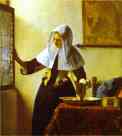
c.1664-1665. Oil on canvas. Metropolitan Museum of Art, New York, USA.